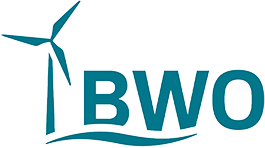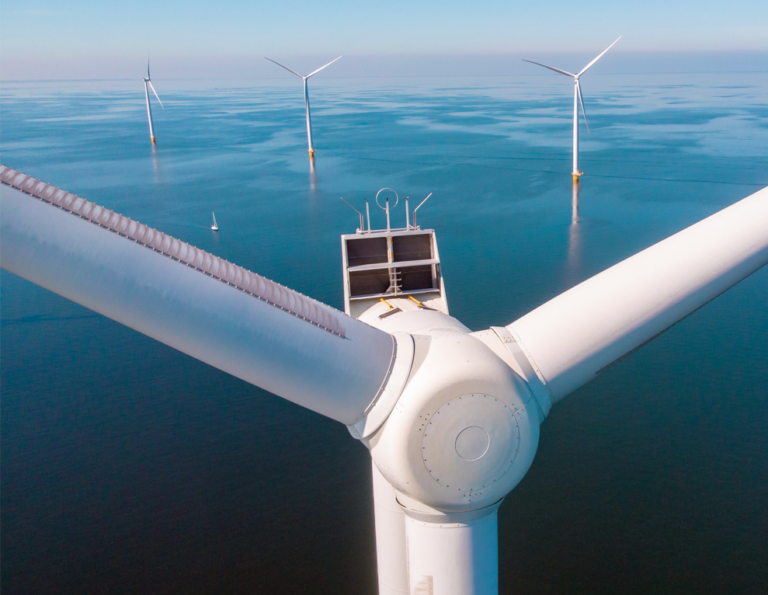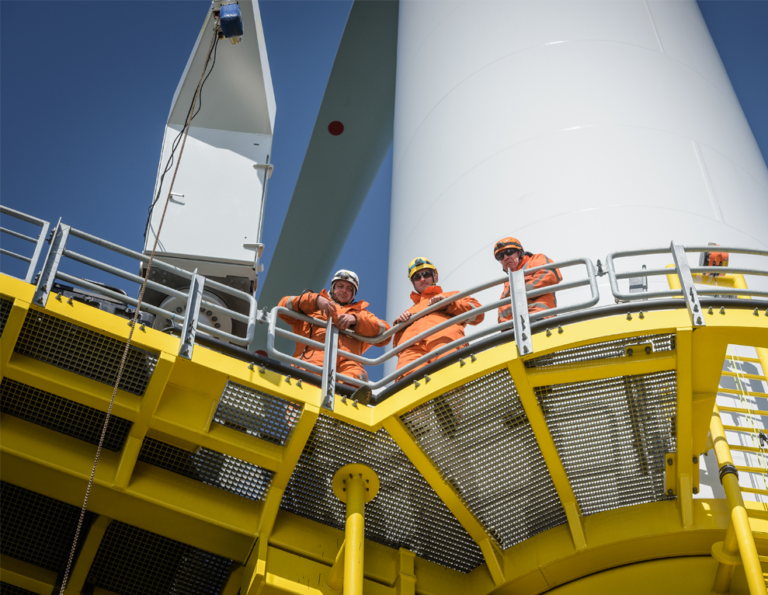Realizing expansion targets for offshore wind energy – planning alone is not enough!
Joint press release by BWO, BWE, Offshore Wind Energy Foundation, VDMA, wab and WindEnergy Network on the expansion figures for 2022
16 January 2023
• 2022 Kaskasi (342 MW) in operation – Arcadis Ost 1 (247 MW) under construction
• Expansion targets for offshore wind energy are increasing throughout the world and Europe
• Less than eight years for around 22 gigawatts of capacity to be installed at sea in
Germany
Germany
• Urgent capacity building for the German and European energy transition
(Supplier industry, ports, shipbuilding, skilled workers) required
(Supplier industry, ports, shipbuilding, skilled workers) required
• Need for adjustment in the WindSeeG
Today, the expansion figures for offshore wind energy 2022 by the German offshore wind industry
presented. Accordingly, last year 38 offshore wind turbines (OWEA) went with one
Output of 342 MW in the Kaskasi project connected to the grid for the first time. Altogether dine with it in the German
North Sea and Baltic Sea 1.539 OWT with a total capacity of 8.100 MW of electricity. Furthermore
all 27 foundations for Arcadis Ost 1 were installed by the end of the year, nine of which have already been completed
equipped with offshore wind turbines. For the current year, with the completion and
Commissioning of Arcadis Ost 1 expected. In the coming years, the German expects
WindGuard for the industry with higher growth rates. The projects to implement the
Tenders from 2023 will take place from 2028. There are a total of 8.800 MW
advertised.
presented. Accordingly, last year 38 offshore wind turbines (OWEA) went with one
Output of 342 MW in the Kaskasi project connected to the grid for the first time. Altogether dine with it in the German
North Sea and Baltic Sea 1.539 OWT with a total capacity of 8.100 MW of electricity. Furthermore
all 27 foundations for Arcadis Ost 1 were installed by the end of the year, nine of which have already been completed
equipped with offshore wind turbines. For the current year, with the completion and
Commissioning of Arcadis Ost 1 expected. In the coming years, the German expects
WindGuard for the industry with higher growth rates. The projects to implement the
Tenders from 2023 will take place from 2028. There are a total of 8.800 MW
advertised.
"In order to achieve the expansion targets by 2030, 22
gigawatts (GW) to be installed at sea. In Europe, around 150
GW of wind energy capacity to be added. The industry therefore expects a significant increase
2025 and especially towards the end of the 2030 expansion target, which requires industrial feasibility.
For the establishment of stable supply chains and a future-oriented expansion of production capacities
it needs a steady and steady growth path. For achieving the expansion goals
The necessary production capacities and skilled workers have so far been substantially lacking. A plan
alone is not enough here. Together with politicians, we must immediately lay down a realistic basis
for the implementation of the expansion goals in the field of offshore wind energy for electricity and green hydrogen
create", warn the industry organizations BWE, BWO, Foundation OFFSHORE-WINDENERGIE, VDMA
Power Systems, WAB eV and WindEnergy Network eV.
gigawatts (GW) to be installed at sea. In Europe, around 150
GW of wind energy capacity to be added. The industry therefore expects a significant increase
2025 and especially towards the end of the 2030 expansion target, which requires industrial feasibility.
For the establishment of stable supply chains and a future-oriented expansion of production capacities
it needs a steady and steady growth path. For achieving the expansion goals
The necessary production capacities and skilled workers have so far been substantially lacking. A plan
alone is not enough here. Together with politicians, we must immediately lay down a realistic basis
for the implementation of the expansion goals in the field of offshore wind energy for electricity and green hydrogen
create", warn the industry organizations BWE, BWO, Foundation OFFSHORE-WINDENERGIE, VDMA
Power Systems, WAB eV and WindEnergy Network eV.
In order to secure the goals, adjustments to the WindSeeG are also necessary. the in
The bid component introduced in WindSeeG 2022 increases the risks for investors and burdens them
Electricity customers with additional rising prices. Because it is clear that the wind farm operators at sea
have to earn back the bid component. The Ukraine war has shown painfully how important
stakeholder diversity. However, there is no guarantee in the current tender design
safety mechanism. Here, the maximum expansion volume to be awarded per bidder and year
be limited. “Due to the large volume of tenders, the government and
Industry work hand in hand from the beginning to avoid rework. That also applies
the preservation of the variety of actors of the project developers", according to the interest groups.
The bid component introduced in WindSeeG 2022 increases the risks for investors and burdens them
Electricity customers with additional rising prices. Because it is clear that the wind farm operators at sea
have to earn back the bid component. The Ukraine war has shown painfully how important
stakeholder diversity. However, there is no guarantee in the current tender design
safety mechanism. Here, the maximum expansion volume to be awarded per bidder and year
be limited. “Due to the large volume of tenders, the government and
Industry work hand in hand from the beginning to avoid rework. That also applies
the preservation of the variety of actors of the project developers", according to the interest groups.
The tenders that will enable incoming orders for the supplier industry are still pending.
Orders are required to "restart" the offshore wind industry for the German
market and the necessary investments in production and supply chain, infrastructure and logistics
enable. “As the offshore wind supply chain grows, a
cost-effective energy supply and greater security of supply in Europe are immense
value creation potential. In addition, there are also long-term and future-oriented options
employment prospects. These must be implemented alongside the necessary climate protection”,
the industry organizations underline the current need for political action.
In 2022, significantly less than one gigawatt was built. Many German supplier companies
are busy with order processing for the international offshore wind market. Another
The materials required for the construction of components for offshore wind turbines are a bottleneck. In addition to the lack of industrial capacity for the expansion of wind energy
port infrastructures are required at sea and a significant increase in the supply of German
Shipyards for the construction of foundation structures, substation and converter platforms, special ships
for service & maintenance and for construction.
Orders are required to "restart" the offshore wind industry for the German
market and the necessary investments in production and supply chain, infrastructure and logistics
enable. “As the offshore wind supply chain grows, a
cost-effective energy supply and greater security of supply in Europe are immense
value creation potential. In addition, there are also long-term and future-oriented options
employment prospects. These must be implemented alongside the necessary climate protection”,
the industry organizations underline the current need for political action.
In 2022, significantly less than one gigawatt was built. Many German supplier companies
are busy with order processing for the international offshore wind market. Another
The materials required for the construction of components for offshore wind turbines are a bottleneck. In addition to the lack of industrial capacity for the expansion of wind energy
port infrastructures are required at sea and a significant increase in the supply of German
Shipyards for the construction of foundation structures, substation and converter platforms, special ships
for service & maintenance and for construction.
Achievement of the expansion targets for offshore wind energy in Germany of at least 30 GW
by 2030, between 40 and 50 GW by 2035 and at least 70 GW by 2045 requires determined
political action. With the realization agreement for more wind energy at sea in November
Milestones for the necessary grid expansion were defined in 2022, which are positive for the industry
evaluated.
by 2030, between 40 and 50 GW by 2035 and at least 70 GW by 2045 requires determined
political action. With the realization agreement for more wind energy at sea in November
Milestones for the necessary grid expansion were defined in 2022, which are positive for the industry
evaluated.
The generation of green hydrogen at sea is still in its infancy and needs the
necessary regulatory framework, the development of concrete business models
allows. Only in this way can the specified ramp-up of hydrogen production from wind energy take place
See through tenders of at least 500 MW per year from 2023.
necessary regulatory framework, the development of concrete business models
allows. Only in this way can the specified ramp-up of hydrogen production from wind energy take place
See through tenders of at least 500 MW per year from 2023.
“The offshore wind industry needs a big one backed by the federal government
Training and qualification offensive, simple investment and financing conditions and
the promotion of new production capacities that provide the necessary liquidity in the manufacturing sector
industry, as well as internationally fair competitive conditions. Especially the measures
of the US Inflation Reduction Act, Europe needs a strong, united response
find,” explain the industry organizations. With a view to the need for skilled workers, the
Associations more freedom of movement for workers beyond EU borders and an effective
immigration policy.
Training and qualification offensive, simple investment and financing conditions and
the promotion of new production capacities that provide the necessary liquidity in the manufacturing sector
industry, as well as internationally fair competitive conditions. Especially the measures
of the US Inflation Reduction Act, Europe needs a strong, united response
find,” explain the industry organizations. With a view to the need for skilled workers, the
Associations more freedom of movement for workers beyond EU borders and an effective
immigration policy.
The press release also in German: 230116_PM_Offshore expansion figures 2023_final_EN
Windguard numbers fact sheet: Status of offshore wind energy expansion_year 2022
Fact sheet with numbers of Windguard: Status of Offshore Wind Energy Development_Year 2022



